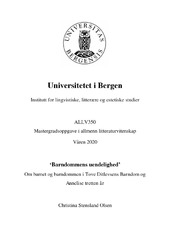'Barndommens uendelighed'
Master thesis
Permanent lenke
https://hdl.handle.net/1956/22855Utgivelsesdato
2020-06-20Metadata
Vis full innførselSamlinger
- Master theses [274]
Sammendrag
The Literary work of Tove Ditlevsen is undergoing a renaissance in the Nordic countries, with new editions being published and read by new generations of readers, proving the prevailing relevance of her authorship. However, this relevancy does not yet seem to have gained academic attention. In addition, the discussion around Ditlevsen’s work seems to almost exclusively revolve around the question of autobiography. I argue that there is one significant topic of Ditlevsen’s writings that is yet to be examined; the theme of childhood. The purpose of the present thesis is therefore to explore how Barndom (1967) and Annelise tretten år (1957) portray what it means to be a child. I will thus examine the premises for how childhood is thematized. After presenting this thesis’ topic of discussion in the first chapter, the second chapter will investigate the novel Barndom. I will examine the development of imagery used in connection to childhood, as a phenomenon with insights from Jean-Pierre Richards L’Univers imaginere de Mallarmé (1962). Next, I will investigate the interplay between the perspectives of the main character and the narrator through narratological terminology. Lastly, I explore, through Julia Kristeva’s theory of the semiotic, how the protagonist’s love for poetry can be connected to her limitations as a child. The third chapter will focus on the children’s novel Annelise tretten år. I will use Henri Bergson’s Le Rire (1900) and Mikhail Bakhtin’s theory of the carnivalesque to shed light on how the child’s perspective poses a distorted and laughable image of the adult world. Lastly, I will discuss what it means to be a child in the novel, with insights from Hans-Georg Gadamer’s theory of play. Ultimately, I argue that both novels inherit projects of liberation, however in very different ways. Barndom illustrates that insights from childhood can only be communicated after the experience is over, and that the story itself is thus a form of prosopopeia. Annelise tretten år, on the other hand, portrays a child in the middle of childhood, which means that within the textual frames, childhood is infinite.
